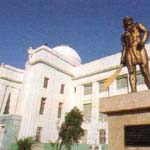| |
|
|
 |
|
PROVINCIAL CAPITOL BUILDING - Osmeña Blvd.
The seat of the provincial government, it is a magnificent edifice of pre-war vintage. The building houses portraits of provincial governors who have served the Cebu province. Its dome can be seen rising while against the backdrop of mountains in the distance. Emanating a semblance of the United States White House, it is one of the many beautiful capitol buildings in the country constructed in 1937 under the administration of Governor Sotero Cabahug. |
|
|
|
|
|
|
|
FUENTE OSMEÑA CIRCLE - Osmeña Boulevard
A circular park with a lovely fountain in the middle, this landmark was named after the Grand Old Man of Cebu, Pres. Sergio Osmeña, Sr. |
|
|
|
|
|
|
|
CASA GORORDO - Lopez Jaena Street
This is the home of the first Filipino bishop, Juan P. Gorordo. A tour of the place will expose you to the kind of lifestyle that existed here in Cebu from 1860 to 1920. |
|
|
|
|
|
|
|
HERITAGE OF CEBU MONUMENT - Colon Street
This monument is the work of national artist Edgardo Castrillo showcasing the important and symbolic events in the history of Cebu dating back to the time of Rajah Humabon to the more recent beatification of Cebuano martyr Pedro Calungsod. |
|
|
|
|
|
|
|
BASILICA MINOR DEL SANTO NIÑO - Zamora Street
This is the oldest church in the country built during the time of Miguel Lopez de Legazpi and Fr. Andres Urdaneta. The place was believed to be the site where the image of Santo Niño was found in 1565. Destroyed by fire in 1568 and rebuilt in 1602, the church was conferred the title Basilica Minor del Santo Niño in 1965 by Cardinal Antonuitte, the Papal Legate during the fourth centennial celebration of teh Christianization of Cebu. |
|
|
|
|
|
|
|
FORT SAN PEDRO - Pier Area
Considered to be the smallest and oldest fort in the country, its construction began in May 8, 1565 during the time of Miguel Lopez De Legazpi. The fort served as the center of the first Spanish settlement in the Philippines. During the American occupation it became the American Warwick barracks and was later converted into classrooms where the Cebuanos received formal education. |
|
|
|
|
|
|
|
MAGELLAN'S CROSS
Known to be the spot where Magellan planted the cross in April 21, 1521, this is where the first Christian Filipinos led by Rajah Humabon and Queen Juana along with 400 followers got their baptism from Fr. Pedro Valderama. It was believe that when the Augustinian priests built and opened the shrine between 1525 to 1740, the natives started to take chips from the cross thinking that it was endowed with miraculous powers. To prevent further destruction of the cross, a kiosk was erected to protect it. |
|
|
|
|
|
|
|
CEBU CITY HALL - M.C. Briones Street
The Cebu City Hall is the seat of power of this Queen City of Southern Philippines. |
|
|
|
|
|
|
|
|
|
|
|
|

